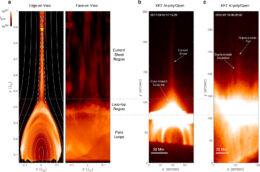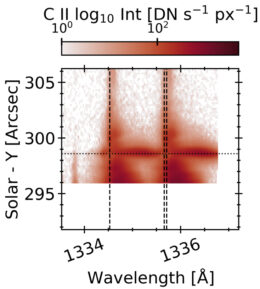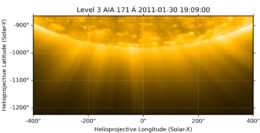Editor’s Note: The Monthly Roundup is a new series that takes a broad view of one astronomical topic each month, exploring it through the lens of 3-5 recent research articles. The first post in this series, published in November, presented JWST observations of the TRAPPIST-1 system.
As we collect more and more high-resolution data of our home star, we find new phenomena that require explanation. This month, we’ll take a look at four research articles that examine different aspects of the Sun, from fine structures to strange flares.
Throwing Turbulence into the Mix
Solar flares are eruptions of high-energy radiation, occurring as frequently as several times a day during the most active part of the solar cycle. Flares are thought to be powered by magnetic reconnection, in which the local solar magnetic field springs into a new configuration and releases magnetic energy. While this model has been hugely successful in explaining various features of solar flares, increasingly precise data have enabled researchers to examine flares more closely, and adjustments to this model may be required to explain the variety of solar flare characteristics across large and small spatial scales.

Comparison of synthesized X-ray Telescope (XRT) images (a) and observations (b and c). Click to enlarge. [Wang et al. 2023]

This 19.3-nanometer image, taken by the Solar Dynamics Observatory on December 11, 2023, shows at the center of the Sun’s disk the remnant of a large coronal hole. [NASA/SDO and the AIA, EVE, and HMI science teams]
Structure Within a Coronal Hole
R. J. Morton and R. Cunningham, both of Northumbria University, examined the small-scale structures seen in observations of a coronal hole by the Solar Dynamics Observatory spacecraft. Coronal holes are most apparent when viewing the Sun at extreme-ultraviolet and X-ray wavelengths, which showcase the Sun’s extremely hot and rarefied upper atmosphere, or corona.
Coronal holes aren’t really holes, but instead areas where the Sun’s magnetic field lines extend into space rather than looping back to the surface. The outstretched magnetic field lines carry plasma out into the solar system, leaving a depleted region of less dense, cooler plasma behind. The cooler plasma emits less radiation and appears as a dark “hole” in the Sun’s bright atmosphere.
The plasma within coronal holes forms column-shaped plumes, within which rapidly varying small-scale structures called plumelets have been found. These structures are thought to be connected to jets that form during magnetic reconnection. To learn more about these structures, Morton and Cunningham analyzed images of a coronal hole from 2011. They found that detailed structures are widespread in plumes and the region between plumes, and the structures are faint, contributing just 1% of the total radiation from that region. The structures are tiny, spanning just a few arcseconds, and their size pushes the resolution limit of current observations. Future observations, such as those made by the Parker Solar Probe as it swings close to the Sun, may be able to reveal structures on even smaller scales, illuminating the connection between plume structure and magnetic reconnection.
Example of the red wings on CII emission lines. The region of interest is marked by the horizontal dashed line. [Adapted from Xu et al. 2023]
Red Wings of a Solar Flare
In March 2022, researchers witnessed a solar flare with some unusual properties. Like many solar flares, this event exhibited two flare ribbons — bright, linear features that appear in the chromosphere, the region between the Sun’s surface and its corona — but it also had an unexpected compact bright region near the ribbons. A team led by Yan Xu (New Jersey Institute of Technology) reported on their investigation of this feature, analyzing images and spectra from several spacecraft. Spectra of the compact emission region show that its emission lines are not symmetrical, but rather have a “wing” that extends in the red (longer-wavelength) direction.
Modeling of these lopsided spectral lines suggested that they were produced by gas plunging downward at 160 kilometers per second — far faster than expected for a typical solar flare. But what could cause the plasma to race downward? Xu’s team suggests that this is an extreme example of a chromospheric condensation, in which plasma in the chromosphere flows downward, propelled by energy output higher in the atmosphere. Though velocities as high as those seen here aren’t unheard of, their rarity and the fact that models of chromospheric condensations struggle to produce such high speeds pose a challenge for future works.
And Now, for Our Space Weather Forecast…
Jihyeon Son (Kyung Hee University) and collaborators applied machine-learning techniques to one of the most pressing problems in solar physics: how to forecast space weather. Space weather refers to the ever-changing plasma environment in our solar system, from the gentle solar wind to powerful coronal mass ejections. By using models to forecast the plasma environment near Earth, researchers explore how conditions near the Sun correlate with conditions near Earth, test their theories of how plasma and magnetic fields behave, and, ultimately, provide a way to predict when damaging space weather will reach us.
Son’s team used a deep-learning model to predict the speed of the solar wind at Earth from extreme-ultraviolet images of the Sun and past measurements of the solar wind speed. Deep learning is a subset of machine learning that uses computing techniques that imitate the way the human brain learns. The team’s model used two neural networks: one to address the extreme-ultraviolet image inputs, and one to handle the past values of the solar wind speed. The two networks are then linked to give a prediction of the solar wind speed at Earth for the next three days.

Predictions of the model used in this work (red line) compared to the output from the model used by the Space Weather Prediction Center (green line) and the actual solar wind speed (gray line). Click to enlarge. [Son et al. 2023]
Citation
“Three-Dimensional Turbulent Reconnection Within the Solar Flare Current Sheet,” Yulei Wang et al 2023 ApJL 954 L36. doi:10.3847/2041-8213/acf19d
“The Fine-Scale Structure of Polar Coronal Holes,” R. J. Morton and R. Cunningham 2023 ApJ 954 90. doi:10.3847/1538-4357/acea7c
“Extreme Red-Wing Enhancements of UV Lines During the 2022 March 30 X1.3 Solar Flare,” Yan Xu et al 2023 ApJ 958 67. doi:10.3847/1538-4357/acf8c6
“Three-Day Forecasting of Solar Wind Speed Using SDO/AIA Extreme-Ultraviolet Images by a Deep-Learning Model,” Jihyeon Son et al 2023 ApJS 267 45. doi:10.3847/1538-4365/ace59a


